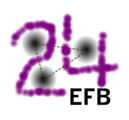Speaker
Description
The attractive nature of $\bar{K}N$ interaction has stimulated theoretical and experimental searches for $K^-$ bound states in different systems. In particular, many theoretical calculations devoted to the lightest possible system $\bar{K}NN$ have been performed using different methods: Faddeev equations with coupled channels, variational methods, and some others. All of them agree that a quasi bound state in the $K^- pp$ system exists but they yield quite diverse binding energies and widths. The experimental situation is unsettled as well: several candidates for the $K^- pp$ state were reported by different experiments, but the measured binding energies and decay widths of such state differ from each other and are far from all theoretical predictions.
Detection of the heavier four-body $\bar{K}NNN$ system could be easier than in the case of $\bar{K}NN$ since direct scattering of $K^-$ on three-body nuclei can be performed. Some theoretical works were devoted to the question of the quasi bound state in the $\bar{K}NNN$ system with different quantum numbers, but more accurate calculations within Faddeev-type equations are needed. The reason is that only these dynamically exact equations written in momentum representation can treat energy dependent $\bar{K}N$ potentials, necessary for the this system, exactly.
We are solving four-body Faddeev equations in AGS form in order to search for the quasi-bound state in the $\bar{K}NNN$ system. We are using our experience with the three-body AGS calculations, and our two-body potentials, constructed for them. Namely, three models of the $\bar{K}N$ interaction are being used: two phenomenological potentials and a chirally motivated one. All three potentials describe low-energy $K^- p$ scattering and $1s$ level shift of kaonic hydrogen with equally high accuracy. This will allow us to study the dependence of the four-body results on the two-body input.
A reliable calculation of a four-body problem is much harder task than a three body one, that is why we are using some approximations. In contrast to our three body calculations, where the coupling between the $\bar{K}N$ and $\pi \Sigma$ channels was taken into account explicitly, here we are using the exact optical (and due to this energy-dependent) $\bar{K}N$ potentials, corresponding to our antikaon-nucleon potentials with coupled channels. We shown that the one-channel three-body calculation with such potential is a very good approximation to the problem with coupled channels and assume that it is true for the four-body case as well. In addition we are using a separable expansion of the three-body
amplitudes, entering the kernels of the four-body equations, in order to reduce the dimension of the system of integral equations. The first peliminary results of the calculations are expected to be ready.




